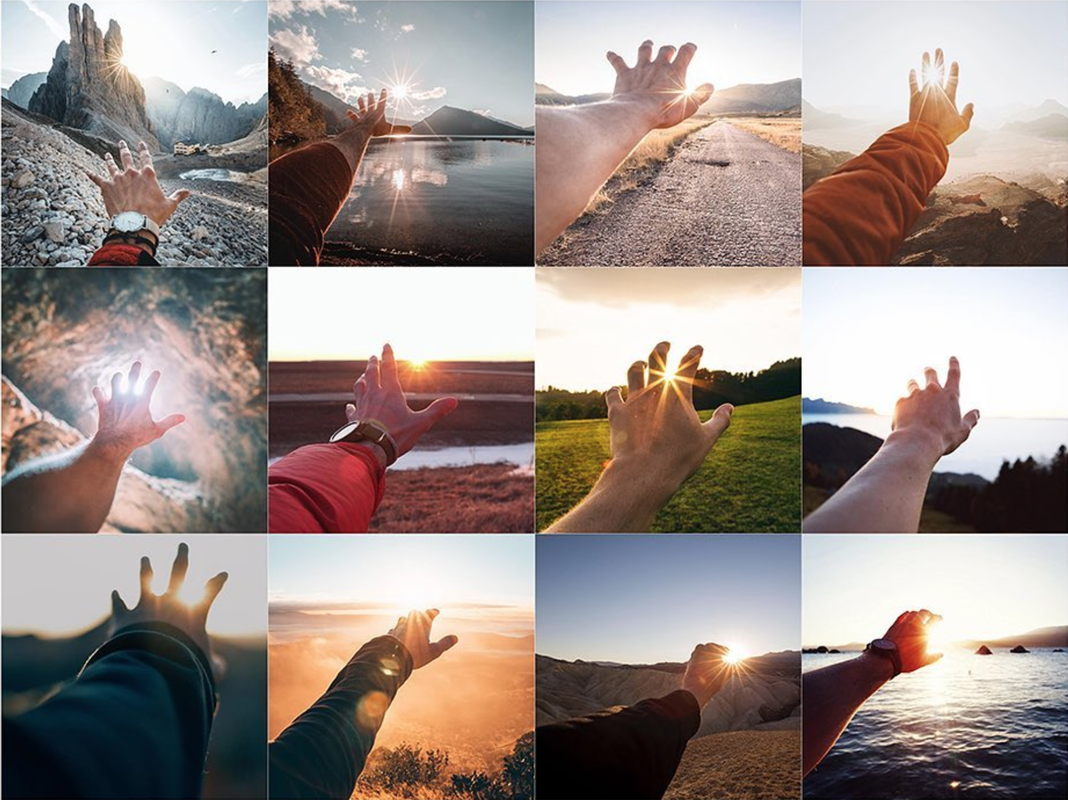Deadline: Photos must be taken by 22nd April (When you come back after Easter)
- (MUST) New Topographics photoshoot – Respond to your chosen New Topographics Photographer and produce a range of images that show your understanding and sense of connection –
- (SHOULD) Respond to the concept of TYPOLOGIES and photograph a series of landscape / architectural features eg GERMAN BUNKERS in a methodical way…
- (COULD) Either – a closer look at architecture…. OR Complete a night-time photoshoot.
See below for ideas on all photoshoots….

1. New Topographics photoshoot (MUST)
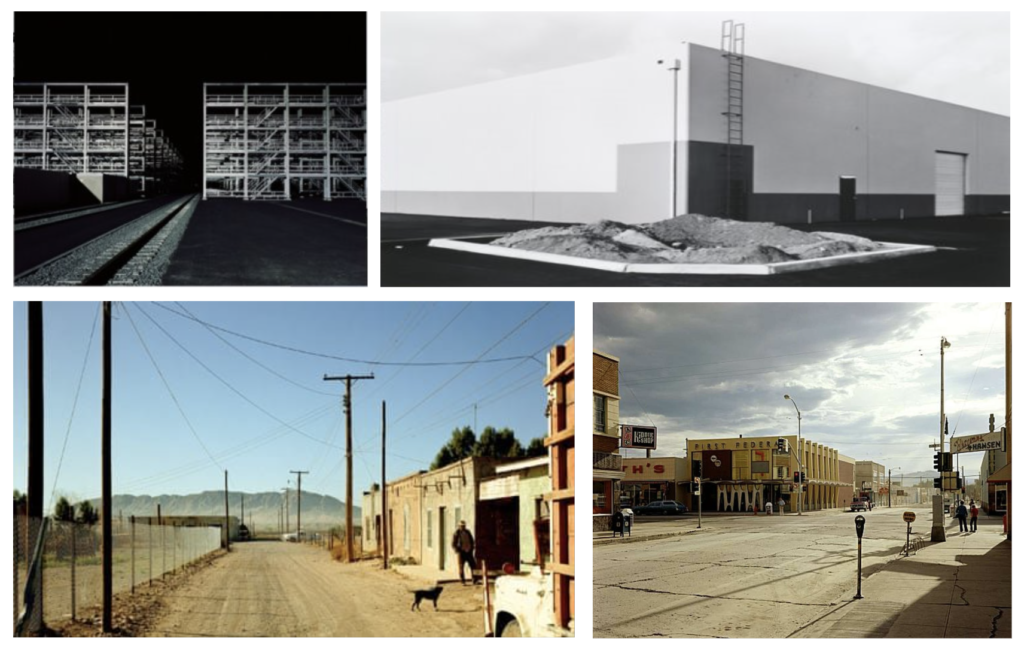
Take a series of photos in response to New Topographics. Your photos should consider:
- Man-altered landscapes
- Deserted spaces
- Harsh lighting
- Minimalistic and formalistic aesthetic
- Straightforward compositions
- Stark geometries and lines
2. Typologies Photoshoot (SHOULD)
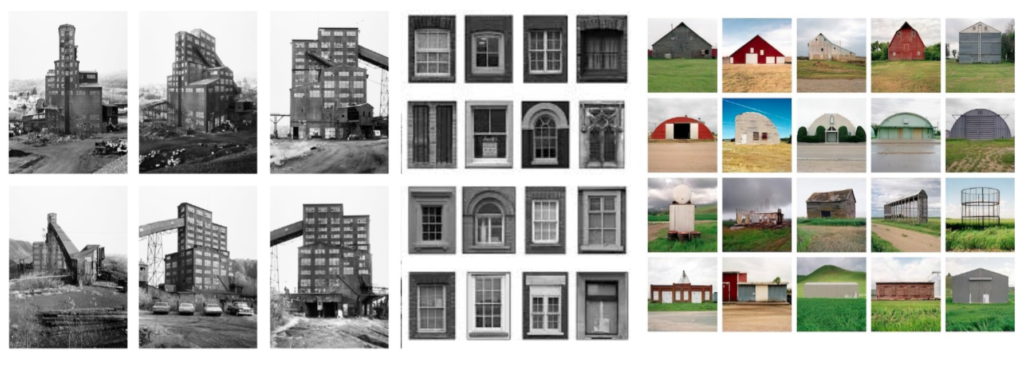
Respond to the concept of TYPOLOGIES and photograph a series of landscape / architectural features eg GERMAN BUNKERS in a methodical way…
- A series of / multiple repetitive photos
- All depicting a particular ‘TYPE’ of landscape / architecture. E.g: A series of photos of bunkers, or a series of photos of homes etc…
- All taken using the same angle /composition / framing
- All edited in the same way
3. A closer look at architecture or night-time photography (COULD)
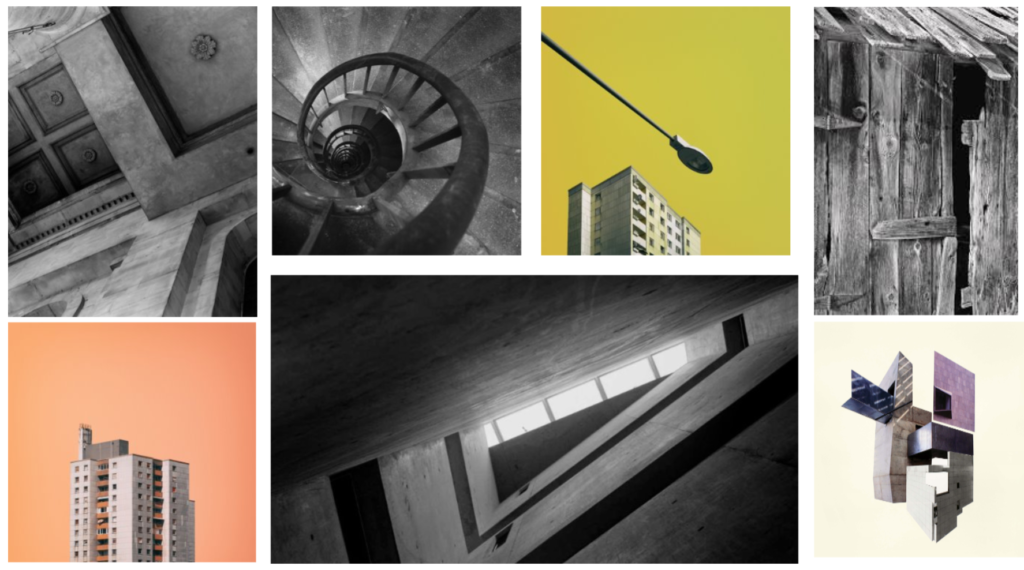
A closer look at architecture:
Consider close up details, different perspectives / angles. This could be modern structures with clean lines and shapes or more rural and rustic buildings
OR… Night Time Photography…
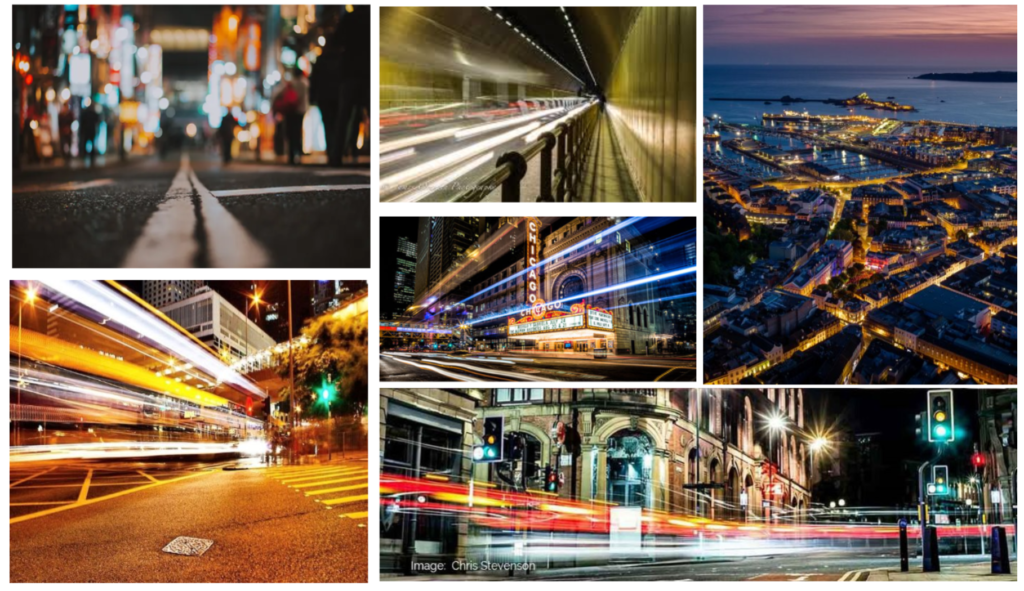
OR night-time photography
Complete a night-time photoshoot…try using long exposures and a tripod / stable surface to capture low light features eg light trails…
Links to more landscape photography ideas…
Landscape Constructions
Constructing a landscape photograph might be different to simply taking one. To construct an image might reveal how and why it has been made. You might construct a photographic image in order to question what a landscape is. What appears natural in the landscape is often the result of careful management. We use nature to construct ideas and stories that reflect our human desires. Constructed landscape photographic images, therefore, reflect the construction of nature itself.
Here are a selection of images by a wide range of artists/photographers. They are all linked by their approach to the construction of landscapes. The artists use photographic techniques to question some of the conventions of landscape photography.
Many of them work with more than one photograph (using layering or collage to build their images). Some use unusual techniques and processes to represent their way of seeing landscapes or their understanding of the forces, like wind and light, at work in nature. Some of the artists use images to question the impact humans have had on the natural world. Some are fascinated by the ways in which we depict and consume nature, whereas others use photography to document a performance or gesture in the landscape. Some of them use analogue techniques, others prefer digital technologies, some even use a combination of both.
None of these artists make straightforward or conventional landscape pictures. Click on each image / link to find out more about the work:
Penelope Umbrico – Sunset Portraits, 2011
Fong Qi Wei – Time in Motion, 2016
Jan Dibbets – Perspective correction – right angle with one diagonal, 1968
Mickalene Thomas – Landscape with Camouflage, 2012
Liesl Pfeffer – Untitled, No. 2, 2018
Andy Goldsworthy – Slate throw Blaenau Ffestiniog, Wales, May, 1980
Jeff Wall – A Sudden Gust of Wind (after Hokusai), 1993
Keith Arnatt – Mirror-Lined Pit (earth bottom), 1968
Joy Gregory – from Sites of Africa, 2016
Jiro Takamatsu – from the series Photograph of Photograph, 1972-3
Andreas Gursky – Rhine III, 2018
John Divola – from the Chroma series, early 1980s
John Baldessari – Junction Series: Seascape, Landscape, Woman and Giraffe (captured), 2002
Zander Olsen – from the Tree, Line series, 2011
Gary Emrich – All Consumed #40, 2017
Myoung Ho Lee – Tree #6, from the series Tree, 2008
Meghann Riepenhoff – from the Littoral Drift series, 2015
Richard Long – A Thousand Stones Thrown Into The River Yangtze, China, 2010
Abelardo Morell – Tent Camera Image on Ground, Grand Teton National Park, Wyoming, 2011
Sarah Anne Johnson – Sunset #2 (Bedazzled), 2018
Bruno V. Roels – Looking fr Paradise (from Fake Billboards), 2018
Zohra Opoku – from Unravelled Threads, 2017
Vanessa March – Untitled No. 72, from The Sun Beneath the Sky series, 2018
Eija-Liisa Ahtila Horizontal – Vaakasuora, 2011
Daisuke Yokota – Outskirts (photobook), 2017
Geraldo de Barros – from Sobras (Remains), 1998
Nick Brandt – Underpass with Elephants (Lean Back Your Life is on Track), 2015
Sohei Nishino – New Hope Creek
Vilde Rolfsen – PLastic Bag Landscapes, 2014
Letha Wilson – Hawaii California Steel (Figure Ground), UV prints on Corten steel, 2017
Yi Dai – Inertia No.1 – from Edinburgh Scotland to London England on 31 August, 2013
Anastasia Samoylova – Tropics, 2014
Noemie Goudal – from the series Soulevements, 2018
Scheltens + Abbenes – Cos, Landscapes, 2018
Viviane Sassen – Wail from Umbra, 2012
Stephen Gill – Hackney Flowers, 2007
Lorenzo Vitturi – from the series Anthropocene, 2011
Maja Strgar Kurečić – from the Escape Landscapes series, 2017
Aletheia Casey – To Dance With Shadows, 2020
Tracey Moffatt – Spirit Landscapes, 2013
Denzel Muhumuza – Watch Me Bloom, 2020
Odette England – from Thrice Upon a Time, 2010
Yichen Zhou – from the ongoing series Daily Talk
Tanja Deman – from Deserted Utopia, 2010
Zeinab Alhashemi – from Urban Phantasmagoria, 2014-2016
Gideon Mendel – Floodlines, 2015-2018
Batia Suter – Wave, floor version #1, 2012
Kristina Jurotschkin – from Nothing But Clouds, 2017
Aliki Braine – Pieces of Sky. Colour photograph from cut and scattered negative, 2020
John Hilliard – Three Uncertain Whites (Winter Landscape), 2015
Hannah Fletcher – What Remains: The Root & The Radical, 2020
Beate Gütschow – HC#02 (Hortus Conclusus series), 2018
Corinne Silva – Garden State, 2015
Corinne Vionnet – Photo Opportunities series, 2005 – ongoing
Victoria Ahrens – Lockdown: A stone’s throw, 2020
Liz Neilsen – Forest Dreams, from the Series Black & Whites, 2020
Alice Duncan – Name Unknown, 2019
Oliver Raymond Barker – Anatomy of Stone, chemigram, 2019
Liz Orton – This Connection Should Make Us Suspect
Victoria Fornieles – Meltdown, 2018
Alexander Mourant – Still from the film A Vertigo Like Self, 2019
Rebecca Najdowski – Interference Pattern, 2018
Marina Caneve – From the series Are They Rocks or Clouds? 2020
Minna Pollanen – From Nature Trail, 2012-2014
Tom Lovelace – Coastal Blocks 8, 2016
Helen Sear – Becoming Forest #7, 2017
Fabio Barile – From Homage to James Hutton #7, 2007
Stefano Canto – Scomposizioni Fotografiche, 2011-15
Martin Seeds – Disagreement iii, Stormont Estate, Belfast, 2018
Mariele Neudecker – And Then The World Changed Colour: Breathing Yellow, 2019
Chloe Sells – from She Said What
Curtis Mann – from Modifications series, 2007-10
Matt Slater – Autumnal Glimpses, No.45, 2019
Aster Reem David – Salt & Light, 2018-ongoing
Brea Souders – from Vistas, 2021
Bindi Vora – from Mountain of Salt, 2021 ongoing
Kate Woods – Double River, 2010
Fabien Barrau – Chicago 2223, 2021
Lewis Bush – Natural History Museum London reclaimed by nature, 2021
Mandy Williams – from Disrupted Landscapes, 2021
Sidonie Hadoux – from Explorations 3, 2019-2021
Viviane Sassen – Axion R02 from Umbra, 2014
Alice Quaresma – New Beginnings, 2019
Marguerite Horay – from Landscape Studies II, 2019
Vltaka Horvat – To See Stars Over Mountains, 2021
Ewa Doroszenko – Exercises of Listening, 2016
Mervyn Arthur – models: materials: tests, 2019
| https://player.vimeo.com/video/190623810?h=b23cd2db33&color=000000&title=0&byline=0&portrait=0 | https://player.vimeo.com/video/566138359?h=be8c025369&title=0&byline=0&portrait=0 |
| Dionne Lee – Drafts, single channel video, 2016 | Ed Carr – Birds in the Sixth Mass Extinction, cyanotype stop motion animation, 2021 |
Suggested activities:
- Once you’ve had a thorough browse through these images, choose 2 or 3 of the artists and try to find out as much as you can about them and their work. As well as reading and making notes you could also start making your own images (still and/or moving) inspired by their work. Making your own photographs is a kind of research.
- You could try identifying some of the themes that connect the images in this gallery above. A theme is a BIG IDEA that connects two or more art works. For example, one theme could be movement. Another could be layers. What other themes can you find?
- Reflect on your own relationship to nature, the natural world, various landscapes and issues connected to the climate emergency. How do you feel about the future of the planet, your access to green spaces, species extinction, pollution and all the other issues related to life on Earth?
- If you live in a town or city your experience of wide open or spectacular landscapes might be quite limited. Perhaps you remember visiting such places during holidays or school trips. Maybe you have lived in another part of the world where the landscapes are very different. Maybe you’ve seen images of landscapes in films, in magazines or on the Internet that are different to the ones where you live. If you live in the countryside, your experience of landscapes might be quite different to that of town or city dwellers. You could create a collage using found images to represent what natural landscapes mean to you.
- You could experiment with creating cameraless images (cyanotype, luminograms or photograms) using cut and torn paper, or other objects and materials, which suggest landscape type compositions.
- Some of the artists included here don’t necessarily think of themselves as photographers. They create performances in natural settings, sometimes referring to these as sculptures or conceptual works of art. A photograph is made as a document because the work of art is not meant to last forever. They are ephemeral. You could experiment with making an ephemeral work of landscape art like this – a walk, a dance, a performance of some sort – in a landscape of your choice. This could be a garden or a nearby park. You could use objects or simply your own body. It’s important not to damage the environment but you could leave a trace of your presence. Take photographs (or get a friend to help you) of your intervention.
- You might want to add a layer of text to your landscape photographs and/or videos, perhaps recording your feelings or documenting other things you saw in the landscape that couldn’t be captured in the image(s).
- Some artists/photographers have created landscape images from unusual materials. How can a plastic bag become a mountainside or waves? Experiment with lighting your choice of materials and framing your shots so that the resulting images are (relatively) convincing landscape photographs.
- Do you have photographs of landscapes that you could cut up and reassemble? Some artists use collage techniques to create new types of images. You could experiment with old 35mm slides, for example, cutting, re-arranging and adding other translucent materials. These could either be re-photographed against a bright background or enlarged on a wall using a slide projector.
- You could experiment with creating a 3D photosculpture made from landscape images. You could even re-photograph your completed sculpture and, using Photoshop or a similar programme, digitally insert it into a real or imaginary landscape.
- How could you photograph a landscape that you’ve never visited or one you can only remember? You could experiment with Google Street View, perhaps revisiting the scene of a family holiday or childhood memory. You could explore the many pictures of a particular place on Flickr, a huge photo sharing site. Some picturesque locations have been visited and photographed millions of times. You could take a look at the Insta Repeat account and try to curate your own galleries of repeated landscape photographs. How has our obsession with social media and the Internet affected our relationship to the natural world?
These are just a few suggestions. There are loads of possibilities. It’s important to experiment, to play, to test new ideas and step outside your comfort zone. Don’t be afraid to try things you’ve not done before. Use your imagination and follow your intuition. How will you construct your landscapes?
Landscape Photography at The Photographers Gallery








